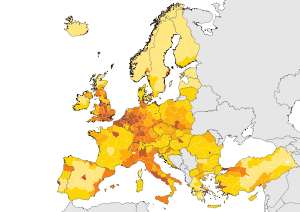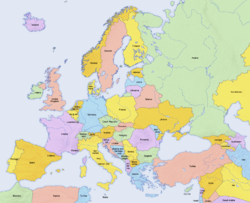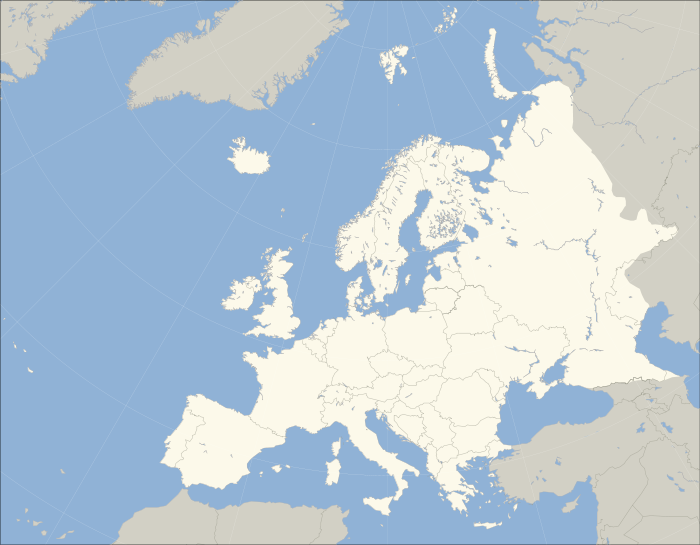
Demographics of Europe
Background Information
SOS Children made this Wikipedia selection alongside other schools resources. Before you decide about sponsoring a child, why not learn about different sponsorship charities first?

Figures for the population of Europe vary according to which definition of European boundaries is used. The population within the standard physical geographical boundaries was 731 million in 2005 according to the United Nations. In 2010 the population is 711 million, using the definition which has been used for centuries, that Europe's boundaries are on the continental divides of the Caucasus and Ural mountains and the Bosporous, including the populated parts of countries of Russia, and a portion of Turkey. Population growth is comparatively slow, and median age comparatively high in relation to the world's other continents.
Since the Renaissance, Europe has had a dominating influence in culture, economics and social movements in the world. European demography is important not only historically, but also in understanding current international relations and population issues.
Some current and past issues in European demography have included religious emigration, ethnic relations, economic immigration, a declining birth rate and an ageing population. In some countries, such as Poland, access to abortion is currently limited and it is entirely illegal in the Mediterranean nation of Malta. In the past, such restrictions and also restrictions on artificial birth control were commonplace throughout Europe. Furthermore, some European countries (currently Belgium, the Netherlands, Luxembourg and Switzerland) have allowed a limited form of voluntary euthanasia. It remains to be seen how much demographic impact this may have.
Total population
In 2007 the population of Europe was estimated to be 731 million according to the United Nations, which was slightly more than 11% of world population. The precise figure depends on the exact definition of the geographic extent of Europe. The population of the EU was 499 million as of 2008. Non-EU countries situated in Europe in their entirety account for another 94 million. Five transcontinental countries have a total of 240 million people, of which about half reside in Europe proper.
A century ago, Europe was home to 25% of the world's population. While the population of the continent has grown, it hasn't come close to the pace of Asia or Africa. As it stands now, around 12% of the world's people live on this continent, but if demographic trends keep their pace, Europe's share may fall to around 7% in 2050. Declining birth rates (particularly in Germany) and a high life expectancy in most European states means that the aging and declining population will be a problem for many European economies, political and social institutions. Countries on the edges of Europe except for Southern Europe have generally stronger growth than Central European counterparts. Albania (Although in Southern Europe) and Ireland have strong growth, all hitting 1%.
Population by country

According to different definitions, such as consideration of the concept of Central Europe, the following territories and regions may be subject to various other categorisations aside from geographic conventions.
| Name of region and territory, with flag |
Area (km2) |
Population (1 July 2010 est.) |
Population density (per km2) |
Capital |
|---|---|---|---|---|
| 28,748 | 2,994,667 | 125.2 | Tirana | |
| 468 | 82,403 | 146.2 | Andorra la Vella | |
| 29,743 | 3,262,000 (in Asia) | 108.4 | Yerevan | |
| 83,858 | 8,414,638 | 100.3 | Vienna | |
| 86,600 | 9,165,000 (nearly all in Asia) | 105.8 | Baku | |
| 207,600 | 9,503,807 | 49.8 | Minsk | |
| 30,510 | 11,007,020 | 336.8 | Brussels | |
| 51,129 | 4,048,500 | 77.5 | Sarajevo | |
| 110,910 | 7,621,337 | 68.7 | Sofia | |
| 56,542 | 4,637,460 | 77.7 | Zagreb | |
| 9,251 | 863,457 (in Asia) | 85.0 | Nicosia | |
| 78,866 | 10,535,811 | 130.1 | Prague | |
| 43,094 | 5,568,854 | 124.6 | Copenhagen | |
| 45,226 | 1,315,681 | 31.3 | Tallinn | |
| 1,399 | 46,011 | 32.9 | Tórshavn | |
| 336,593 | 5,357,537 | 15.3 | Helsinki | |
| 551,695 | 63,460,000 | 115.0 | Paris | |
| 69,700 | 4,461,473 (mostly in Asia) | 64.0 | Tbilisi | |
| 357,021 | 81,757,600 | 233.2 | Berlin | |
| 5.9 | 27,714 | 4,697.3 | Gibraltar | |
| 131,940 | 11,645,343 | 80.7 | Athens | |
| 2,166,086 | 56,452 | 0.027 | Nuuk | |
| 78 | 66,587 | 828.0 | St. Peter Port | |
| 93,030 | 9,979,000 | 108.3 | Budapest | |
| 103,000 | 304,261 | 2.7 | Reykjavík | |
| 70,280 | 4,434,925 | 60.3 | Dublin | |
| 572 | 80,873 | 129.1 | Douglas | |
| 301,230 | 60,418,711 | 191.6 | Rome | |
| 116 | 89,775 | 773.9 | Saint Helier | |
| |
10,908 | 1,733,872 | 159.0 | Pristina |
| 64,589 | 2,366,515 | 36.6 | Riga | |
| 160 | 35,322 | 205.3 | Vaduz | |
| 65,200 | 3,401,138 | 55.2 | Vilnius | |
| 2,586 | 472,569 | 173.5 | Luxembourg | |
| 25,713 | 2,054,800 | 81.1 | Skopje | |
| 316 | 408,009 | 1,257.9 | Valletta | |
| 33,843 | 3,834,547 | 131.0 | Chişinău | |
| 1.95 | 32,087 | 16,403.6 | Monaco | |
| 13,812 | 672,180 | 44.6 | Podgorica | |
| 41,526 | 16,696,700 | 393.0 | Amsterdam | |
| 324,220 | 4,930,116 | 14.0 | Oslo | |
| 312,685 | 38,192,000 | 123.5 | Warsaw | |
| 91,568 | 10,607,995 | 110.1 | Lisbon | |
| 238,391 | 19,042,936 | 80.0 | Bucharest | |
| 17,075,400 (3,960,000 in European Russia) | 142,905,208 (110,000,000 in European Russia) | 8.3 (27.8 in European Russia) | Moscow | |
| 61 | 31,730 | 454.6 | San Marino | |
| 88,361 | 7,345,000 | 94.8 | Belgrade | |
| 48,845 | 5,422,366 | 111.0 | Bratislava | |
| 20,273 | 2,012,917 | 95.3 | Ljubljana | |
| 504,851 | 47,150,800 | 89.3 | Madrid | |
Mayen Islands (Norway) |
62,049 | 2,868 | 0.046 | Longyearbyen |
| 449,964 | 9,360,113 | 19.7 | Stockholm | |
| 41,290 | 7,785,000 | 176.8 | Bern | |
| 744,820 | 73,722,988 (10,920,000 in Europe) | 98.9 | Ankara | |
| 603,628 | 45,939,820 | 76.0 | Kiev | |
| 244,820 | 62,041,708 | 244.2 | London | |
| 0.44 | 900 | 2,045.5 | Vatican City | |
| Total | 10,180,000 | 711,064,145 | 69.85 | |
| |
1,551 | 26,008 | 16.8 | Mariehamn |
Population map (Numbers in thousands)
Sea
Biscay
Sea
Sea
Cadiz
Sea
Sea
Age
Perhaps mirroring its declining population growth, European countries tend to have older populations overall. European countries had nine of the top ten highest median ages in national populations in 2005. Only Japan had an older population.
Religion
Over the last several decades, religious practice has been on the decline in a process of " Secularization." European countries have experienced a decline in church attendance, as well as a decline in the number of people professing a belief in a god. The Eurobarometer Poll 2010 found that, on average, 51% of the citizens of EU member states state that they believe in a god, 26% believe there is some sort of spirit or life Force while 20% do not believe there is any sort of spirit, god or Life Force, and 3% declined to answer. According to a recent study, 47% of Frenchmen declared themselves as agnostic in 2003. This situation is often called " Post-Christian Europe".
A decrease in religiousness and church attendance in western Europe (especially Belgium, Czech Republic, Finland, France, Germany, United Kingdom, Norway, the Netherlands and Sweden) has been noted. The Eurobarometer poll must be taken with caution, however, as there are discrepancies between it and national census results. For example in the United Kingdom, the 2001 census revealed over 70% of the population regarded themselves as "Christian" with only 15% professing to have "no religion", though the wording of the question has been criticized as "leading" by the British Humanist Association.
Ethnic groups
Pan and Pfeil (2004) count 87 distinct "peoples of Europe", of which 33 form the majority population in at least one sovereign state, while the remaining 54 constitute ethnic minorities. The total number of national minority populations in Europe is estimated at 105 million people, or 14% of 770 million Europeans.(including europeans in asian russia)
The largest ethnic groups are the Russians, of whom 92 million reside in Europe, the Germans, with 82 million. In some countries such as the United Kingdom, France and Spain, the designation of nationality may controversially take on ethnic aspects, subsuming smaller ethnic groups such as Welsh, Bretons and Basques, making it difficult to quantify a "British" or "French" ethnicity, for example.
Non-European immigrant groups (Middle Eastern, African, Asian, American etc.) account for about 3% to 4% of the European population or 22 to 30 million people.
|
||||||||
Language
Most of the languages of Europe belong to the Indo-European language family. This family is divided into a number of branches, including Romance, Germanic, Baltic, Slavic, Albanian, Celtic and Greek. The Uralic languages, which include Hungarian, Finnish, and Estonian, also have a significant presence in Europe. The Turkic and Mongolic families also have several European members, while the North Caucasian and Kartvelian families are important in the southeastern extremity of geographical Europe. The Basque language of the western Pyrenees is an isolate unrelated to any other group, while Maltese is the only Semitic language in Europe with national language status.
The European Union (EU), which currently excludes many European countries (i.e. Norway, Russia and Switzerland), recognises 23 official languages as of 2007. According to the same source, the eight most natively spoken languages in the EU are (percentage of total EU population):
These figures change when foreign language skills are taken into account. The list below shows the top eight European languages ordered by total number of speakers in the EU:
- 49% English
- 35% German
- 26% French
- 16% Italian
- 15% Spanish
- 10% Polish
- 7% Russian
- 6% Dutch
This makes German the most frequently spoken native language and English the most frequently spoken non-native language overall in the European Union, with German the second-most common language overall.
Languages that are not official state languages are protected in many European countries by the European Charter for Regional or Minority Languages. These can include languages spoken by relatively many people, such as Catalan and Basque in Spain, as well as languages spoken by relatively few such as Welsh, Cornish and Scottish Gaelic in the United Kingdom.
Genetic origins
Homo sapiens appeared in Europe roughly 40,000 years ago, with the settlement of the Cro-magnons. Over the prehistoric period there was continual immigration to Europe, notably by the immediate descendents of the Proto-Indo-Europeans who migrated west after the advent of the Neolithic revolution.
MtDna and Y-Dna
Studies of mitochondrial DNA (mtDNA) have suggested substantial genetic homogeneity of European populations, with only a few geographic or linguistic isolates appearing to be genetic isolates as well. On the other hand, analyses of the Y chromosome and of autosomal diversity have shown a general gradient of genetic similarity running from the southeast to the northwest of the continent.
But, well-known areas with Mt-Dna and Y-Dna differences, discovered by grouping and tracking prehistorical genotype migrations, are in Iberia, in relation to the Basques of northern Spain and southwest France; and the Balkans of southeast Europe. Both were areas of refuge where early modern humans settled over 50,000 years ago, during the last ice age.
Population structure
A very recent study in May 2009 that studied 19 populations from Europe using 270,000 SNPs highlighted the genetic diversity of European populations corresponding to the northwest to southeast gradient and distinguished "four several distinct regions" within Europe:
- Finland, in relation to the Saami.
- the Baltic states (Estonia, Latvia and Lithuania), western Russia and Poland.
- Central and Western Europe.
- Italy, South-Eastern Europe, Southern Russia.
In this study, Fst ( Fixation index) was found to correlate considerably with geographic distances ranging from ≤0.0010 for neighbouring populations to 0.0230 for Southern Italy and Finland. For comparisons, pair-wise Fst of non-European samples were as follows: Europeans – Africans (Yoruba) 0.1530; Europeans – Chinese 0.1100; Africans (Yoruba) – Chinese 0.1900.






